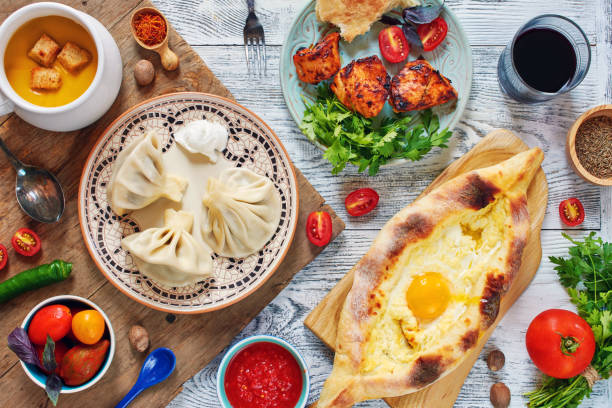Unveiling the Charms of Georgian Cuisine: A Journey to the Caucasus
From the rugged peaks of the Caucasus mountains to the fertile valleys of the Alazani, Georgia's diverse geography has given rise to a rich culinary tradition that is as varied as the land itself. Let us delve into the delights of Georgian cuisine and discover why it is gaining worldwide recognition.

The Heart of Georgian Cuisine: Supra
The Georgian supra, or feast, is an integral part of Georgian social culture. Traditional dishes are shared among guests amidst flowing wine and heartfelt toasts. These gatherings are a testament to the Georgians’ reverence for food and fellowship.
The Staples: Bread and Cheese
At the heart of Georgian cuisine are bread and cheese. Khachapuri, a traditional Georgian bread filled with melting cheese, is a national favorite. Another popular bread, Shoti, is cooked in a clay oven, known as a tone, and has a distinct, smoky flavor.
The Spice Palette: Unique and Exotic
Georgian spices lend a unique flavor profile to the cuisine, with combinations that are rarely found elsewhere. Blue fenugreek, marigold, and Svanetian salt are just a few examples of the exotic spices that give Georgian dishes their distinctive taste.
Wine: An Ancient Tradition
Georgia is often referred to as the ‘Cradle of Wine.’ Archaeological evidence suggests that Georgians were producing wine as early as 6000 B.C., making it one of the oldest winemaking countries in the world. Traditional Georgian wine is made in clay vessels, known as qvevri, buried in the ground.
The Sweet Tooth: Churchkhela and Pelamushi
Georgian desserts are simple yet satisfying. Churchkhela, a candle-shaped candy made of grape juice, nuts, and flour, is a common sight in local markets. Pelamushi, a type of pudding made from grape juice and cornmeal, is another popular treat.
Curious Facts and Tips about Georgian Cuisine
- Georgian food is often accompanied by traditional polyphonic singing.
- Georgians have a unique way of toasting, often delivered in verse form.
- Many Georgians still use traditional cooking methods, including clay ovens and open fires.
In conclusion, Georgian cuisine offers a unique culinary experience that reflects the country’s rich history and diverse geography. With its unique flavors, time-honored traditions, and heartwarming hospitality, it’s no wonder Georgian cuisine is gaining global recognition. So the next time you’re in search of new flavors, why not embark on a culinary journey to the Caucasus? You might just fall in love with the charms of Georgian cuisine.




